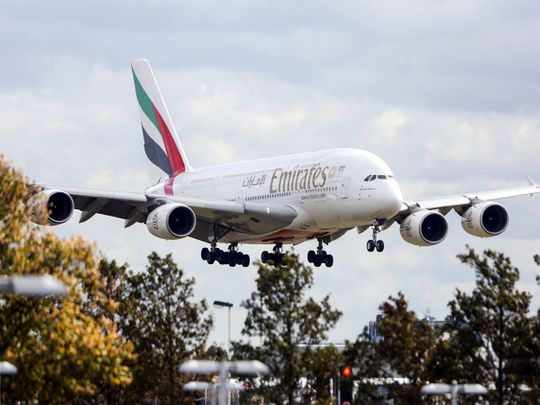
Dubai’s Emirates remained among the world’s top 10 airlines by passenger traffic, while flydubai marched up several slots, as aviation data and analytics firm Cirium released its airline passenger rankings for 2021.
Emirates recorded an RPK (revenue passenger kilometres) of 93.8 billion (231 per cent up over 2020 levels), while ASK (available seat kilometres) stood at 160 billion (150 per cent up compared to 2020). Emirates carried 19.6 million passengers in 2021, a jump of nearly 200 per cent compared to 2020 levels.
The top four slots in the list were occupied by US carriers – American Airlines, Delta Air Lines, United Airlines, Southwest Airlines. Ryanair and China Southern took the next two slots, while Emirates ranked seventh, followed by Qatar Airways. China Eastern Airlines ranked ninth, while Turkish Airlines was placed tenth.
Flydubai ranked 63 on the list, a massive jump from its 101st slot in 2019. The airline’s RPK stood at 12.8 billion (up 89 per cent) compared to 2020 levels, while ASK was at 19.1 billion (a 99 per cent jump of 2020). The airline carried 5.6 million passengers in 2021, a 75 per cent jump compared to 2020 levels.
Abu Dhabi-based Etihad ranked 60th on the list, while Sharjah’s Air Arabia ranked 93rd.
In terms of passenger numbers, the total globally stood at 2.3 billion for the year, representing around half of the volumes from the peak in 2019.
“The decline is starker still for traffic figures measured in Revenue Passenger Kilometers (RPKs). Due to the relatively steeper decline of long-haul flying – across borders with increasing levels of restriction – traffic fell a full two-thirds in 2020 and a year later was still some 57 per cent below the 2019 peak,” Cirium said in its report.
The report pointed out that as COVID rapidly worked its way around the world during the first few months of 2020, the resulting impact was relatively uniform. “The main standout was among Middle-Eastern carriers who saw 80 per cent of traffic disappear from their long-haul, and often highly connected networks. Elsewhere traffic declines were grouped around the 60-70 per cent mark.”
Here, it’s important to note that unlike most American, European and Asian carriers who operate a significant number of domestic flights along with international ones, the top airlines in the Middle East mostly serve only international destinations. While airports in the Middle East opened swiftly after the pandemic, other countries failed to do so, thereby limiting the flights Gulf carriers could operate in those countries.
“By the end of last year, North America’s airlines had reduced their traffic decline to 40 per cent against 2021 and in terms of passenger volume the fall was at a third, driven by recovery in US domestic flying where border restrictions are obviously not an issue,” the report said.
The performance of Emirates and flydubai also reflects in the passenger numbers at Dubai International Airport, the hub for both these carriers. DXB’s half yearly traffic this year stood at 27.9 million passengers, just 1.2 million shy of the airport’s total annual traffic last year.
This was the ninth successive quarter since the start of the pandemic that the airport maintained its growth recovery. DXB recorded 14.2 million passengers in the second quarter of 2022, a year-on-year jump of 190.6 per cent. The H1 traffic volume represents 67.5 per cent of DXB’s pre-pandemic passenger traffic during the same period in 2019.
Struggling regions
Having weathered the initial crisis no worse than in other regions, Asia Pacific airlines were alone in taking a further backward step in 2021, posting a further double-digit decline as markets faltered and fresh fears of COVID drove renewed border restrictions, the report said.
“Carriers such as Asiana and AirAsia all lost their traditional place among the top 50 passenger airlines in the latest ranking. But none quite matched the spectacular fall of Cathay Pacific as it slipped over 130 places amid Hong-Kong’s pursuit of an aggressive zero-COVID strategy.”
Asia Pacific also lost its place as home to the world’s largest share of airline traffic. The region’s carriers accounted for over a third of global traffic going into the pandemic and grew that share in 2020 as COVID ramped up in other parts of the world during the year.











